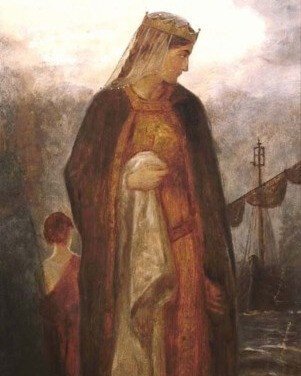~ The legend of Guinevere, Geoffrey of Monmouth ~
Geoffrey of Monmouth (c. 1100-1155) establishes the basic outline of the Arthurian Legend in his History of the Kings of Britain which features many of the central characters who would later be developed by other writers, including Guinevere. Geoffrey calls her Gwenhuvara from the Welsh name Gwenhwyvar. The name Gwenhwyvar (meaning unknown) appears in earlier Welsh folklore referencing a woman of bad reputation.
Precisely what this early Gwenhwyvar did is unclear, but in Geoffrey's work, she is simply Arthur's queen, a ward of the Lord Cador of Cornwall, and a great beauty of Roman descent. When Arthur leaves Britain to wage war on the continent, he leaves Guinevere in the care of his nephew Mordred who seduces her and usurps the throne. Arthur returns to rescue his queen and kingdom, but Guinevere, stricken with guilt, flees the kingdom and enters a nunnery. Mordred is killed in battle, and Arthur, mortally wounded, is taken away to the Isle of Avalon.
Geoffrey provides no details of Guinevere's infidelity, only writing : Message was brought to [Arthur] that his nephew Mordred, unto whom he had committed the charge of Britain, had tyrannously and traitorously set the crown of the kingdom upon his own head and had linked himself in unhallowed union with Gwenhuvara the Queen in despite of her former marriage. (Book X.13)
Painting : The Rescue of Guinevere by William Hatherell
#guinevere #lancelot #kingarthur #art #mythology #legend #arthistory #history #painting #womenfromhistory

